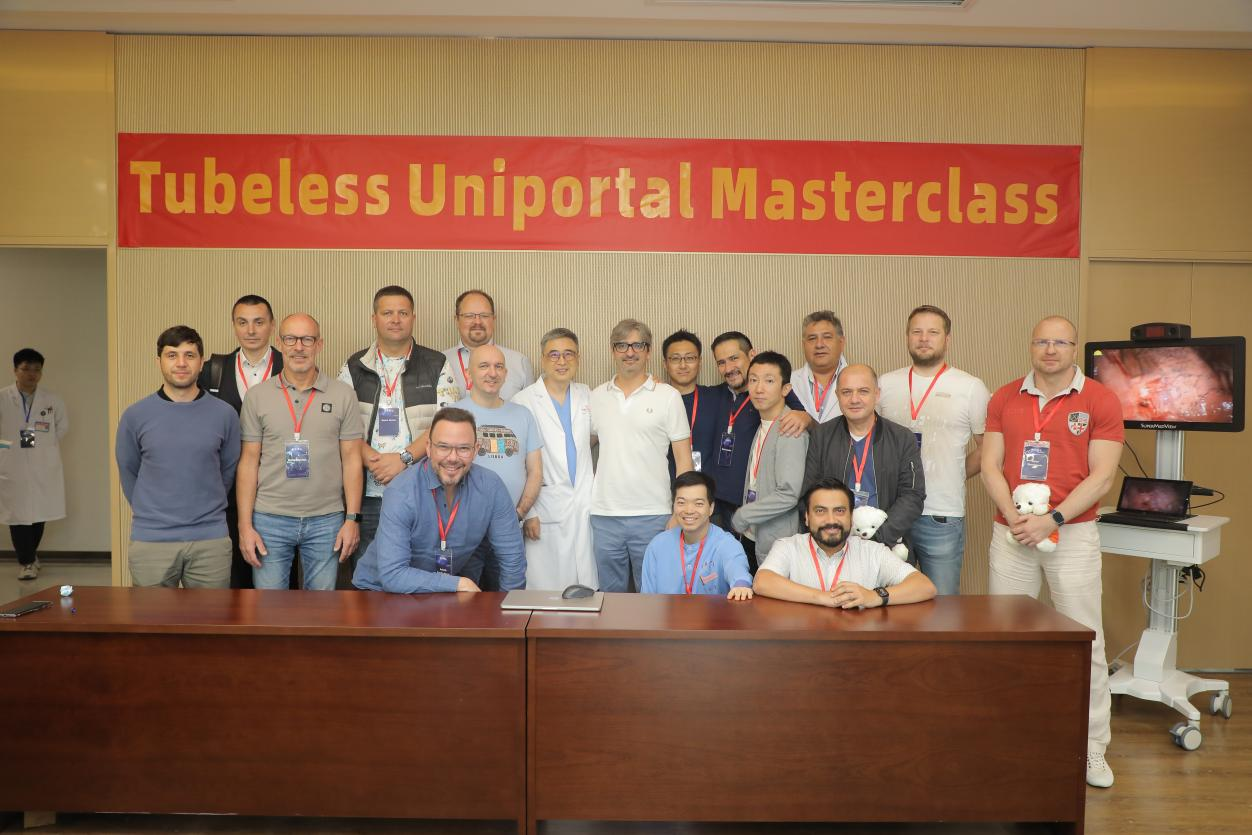From October 20 to 22, the 24th Tubeless Thoracic Masterclass rode the "wind" of the Canton Fair, attracting 34 renowned medical experts from 30 medical centers in the UK, Spain, Australia, and more to The First Affiliated Hospital of Guangzhou Medical University and the National Center for Respiratory Medicine. They observed and experienced the “Chinese solution” of minimally invasive thoracic surgery technology—the Tubeless thoracic technology, pioneered by Professor He Jianxing’s team, showcasing Eastern wisdom and Chinese solutions to global thoracic surgery experts.
01 Tubeless Minimally Invasive: Leading Edge of International Minimally Invasive Thoracic Surgery Technology
The Tubeless technique, which involves tubeless thoracic surgery under spontaneous breathing anesthesia, is an internationally leading technology independently developed and fully promoted by Professor He Jianxing’s team at the National Center for Respiratory Medicine and The First Affiliated Hospital of Guangzhou Medical University. Patients maintain spontaneous breathing during surgery, significantly reducing postoperative complications and the use of sedatives and muscle relaxants, as well as the side effects associated with anesthesia.
During this masterclass, international participants observed the application of the Tubeless technique in complex surgical scenarios such as lobectomy, tracheal and carinal resection, and lung transplantation. They witnessed the significant role of the “tubeless” technology in promoting rapid postoperative recovery and precision medicine, providing new solutions to numerous challenges in thoracic surgery.

Dr. Narasimhan from India expressed his amazement after observing the demonstration of a “tubeless” single-port thoracoscopic lung cancer radical surgery by Professor He’s team. He saw a patient sitting up the day after surgery to listen to his own breath and even get up to engage in rehabilitation training. Dr. Narasimhan exclaimed, “It’s amazing! I didn’t expect lung cancer surgery could reach such a level, with patients recovering so quickly! Upon returning to his country, he plans to use the tubeless technique for early-stage lung cancer patients, ensuring that patients in his country can also benefit from this new technology.”
Traditional lung transplantation surgeries rely on tracheal intubation and mechanical ventilation, sometimes even requiring ECMO, resulting in a poor postoperative recovery experience. The spontaneous breathing anesthesia technique completely overturns this model, allowing patients to retain spontaneous breathing while minimizing the damage to donor lungs from mechanical ventilation, significantly reducing infection risks, and importantly, decreasing the toxic side effects from excessive medication, leading to shorter hospital stays and lower treatment costs.
Greek thoracic doctor Klimatsidas visited China for the first time. He had seen videos of the tubeless technology online and was curious about it. After witnessing its real-world application, he stated, “It’s even more amazing than I imagined!” He remarked, “I never expected tubeless technology could be applied in the high-difficulty field of lung transplantation. For patients, the experience is better, and recovery will be faster. This is a unique innovation from China!”
This masterclass not only welcomed thoracic surgeons but also specifically hosted nine anesthesiologists, six of whom were recommended by doctors who had completed the training. Dr. Ronald Madarang, an anesthesiologist from the Philippines, shared that he was interested in the “tubeless” non-intubation spontaneous breathing anesthesia technique based on recommendations from their surgical team. During his visit to China, he not only witnessed a modern hospital and advanced medical equipment but also got to know an excellent medical team. He was deeply impressed by the “tubeless” technology, stating, “We saw that this technology allows for rapid recovery for patients, and I am confident in bringing this remarkable technique back to the Philippines for clinical application.”
02 Technological Empowerment: AI + Naked Eye 3D + Single-Port Snake Arm Surgical Robot Thoracic Surgery
During the training, Professor He’s team showcased the independently developed naked eye 3D surgical display system. This system provides a more intuitive perspective for surgeons through high-definition imaging and precise operational control. The domestic snake-arm robot, with its unique flexibility and precision, easily completes delicate tissue separation and cutting tasks under the surgeon’s operation, impressing international participants with the perfect integration of Chinese innovative concepts and technologies.

Dr. María from Mexico expressed her thoughts after experiencing the single-port snake-arm surgical robot, saying, “Its operation is not as complicated as I imagined, and the improvements in patient experience left a deep impression on me.”
03 Integration of Chinese and Western Medicine: Facilitating Deep Integration of Techniques and Concepts in the Field of Thoracic Surgery
This masterclass specially invited renowned global thoracic surgery expert Professor Diego González-Rivas to share his extensive experience in single-port robotic thoracic surgery. As one of the promoters of the tubeless technique, he emphasized the key role of AI technology in future surgeries, particularly in complex procedures like tracheal and carinal resections, further broadening the participants’ understanding of cutting-edge technology.

Participants from around the world not only learned the practical operation of tubeless surgery but also gained insights through on-site visits, deeply understanding China’s advanced experiences in intelligent management, innovation in medical services, and application of AI technology. This deep integration of technology and concepts across borders vividly embodies the theme of the 136th Canton Fair: “Serving High-Quality Development, Promoting High-Level Openness” in the medical field.
“This is not only a technological advancement but also a pinnacle dialogue among global thoracic surgeons,” Professor He Jianxing stated. He hopes to immerse participants in these innovative technologies through practical surgical demonstrations, allowing them to experience the future direction of thoracic surgery. “Tubeless technology, as an important direction for the future development of thoracic surgery, is leading the trend of thoracic surgery worldwide.”

